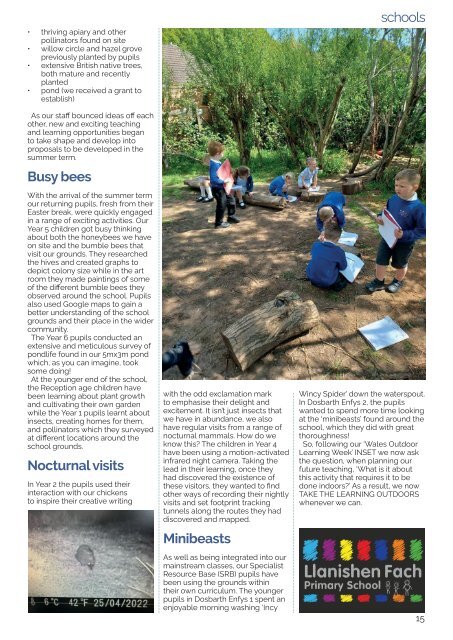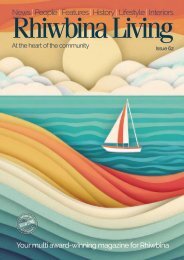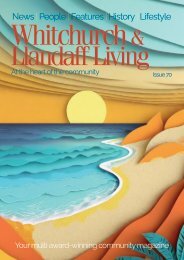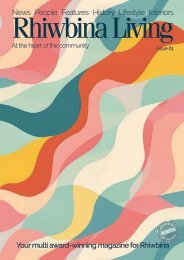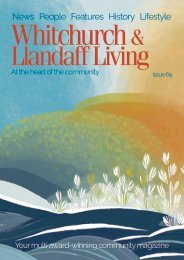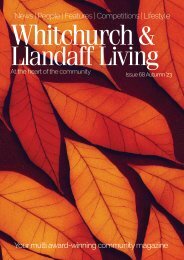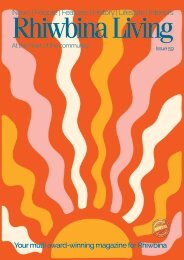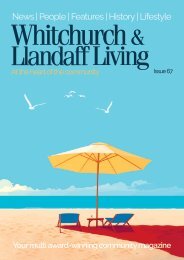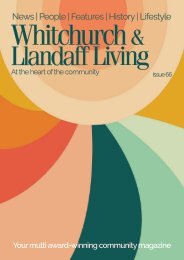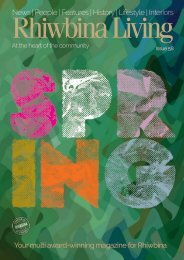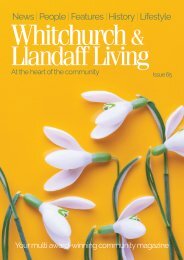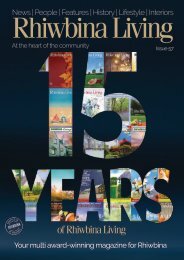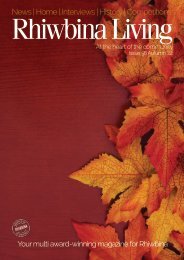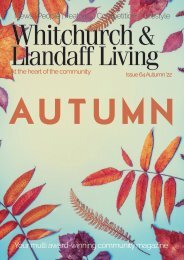Rhiwbina Living Issue 55
Summer 2022 issue of the award-winning magazine for Rhiwbina.
Summer 2022 issue of the award-winning magazine for Rhiwbina.
You also want an ePaper? Increase the reach of your titles
YUMPU automatically turns print PDFs into web optimized ePapers that Google loves.
• thriving apiary and other<br />
pollinators found on site<br />
• willow circle and hazel grove<br />
previously planted by pupils<br />
• extensive British native trees,<br />
both mature and recently<br />
planted<br />
• pond (we received a grant to<br />
establish)<br />
As our staff bounced ideas off each<br />
other, new and exciting teaching<br />
and learning opportunities began<br />
to take shape and develop into<br />
proposals to be developed in the<br />
summer term.<br />
Busy bees<br />
With the arrival of the summer term<br />
our returning pupils, fresh from their<br />
Easter break, were quickly engaged<br />
in a range of exciting activities. Our<br />
Year 5 children got busy thinking<br />
about both the honeybees we have<br />
on site and the bumble bees that<br />
visit our grounds. They researched<br />
the hives and created graphs to<br />
depict colony size while in the art<br />
room they made paintings of some<br />
of the different bumble bees they<br />
observed around the school. Pupils<br />
also used Google maps to gain a<br />
better understanding of the school<br />
grounds and their place in the wider<br />
community.<br />
The Year 6 pupils conducted an<br />
extensive and meticulous survey of<br />
pondlife found in our 5mx3m pond<br />
which, as you can imagine, took<br />
some doing!<br />
At the younger end of the school,<br />
the Reception age children have<br />
been learning about plant growth<br />
and cultivating their own garden<br />
while the Year 1 pupils learnt about<br />
insects, creating homes for them,<br />
and pollinators which they surveyed<br />
at different locations around the<br />
school grounds.<br />
Nocturnal visits<br />
In Year 2 the pupils used their<br />
interaction with our chickens<br />
to inspire their creative writing<br />
with the odd exclamation mark<br />
to emphasise their delight and<br />
excitement. It isn’t just insects that<br />
we have in abundance, we also<br />
have regular visits from a range of<br />
nocturnal mammals. How do we<br />
know this? The children in Year 4<br />
have been using a motion-activated<br />
infrared night camera. Taking the<br />
lead in their learning, once they<br />
had discovered the existence of<br />
these visitors, they wanted to find<br />
other ways of recording their nightly<br />
visits and set footprint tracking<br />
tunnels along the routes they had<br />
discovered and mapped.<br />
Minibeasts<br />
As well as being integrated into our<br />
mainstream classes, our Specialist<br />
Resource Base (SRB) pupils have<br />
been using the grounds within<br />
their own curriculum. The younger<br />
pupils in Dosbarth Enfys 1 spent an<br />
enjoyable morning washing ‘Incy<br />
schools<br />
Wincy Spider’ down the waterspout.<br />
In Dosbarth Enfys 2, the pupils<br />
wanted to spend more time looking<br />
at the ‘minibeasts’ found around the<br />
school, which they did with great<br />
thoroughness!<br />
So, following our ‘Wales Outdoor<br />
Learning Week’ INSET we now ask<br />
the question, when planning our<br />
future teaching, ‘What is it about<br />
this activity that requires it to be<br />
done indoors?’ As a result, we now<br />
TAKE THE LEARNING OUTDOORS<br />
whenever we can.<br />
15


